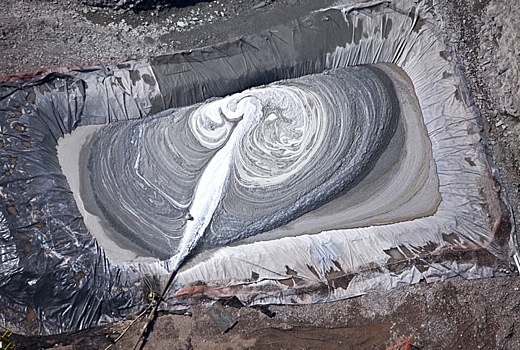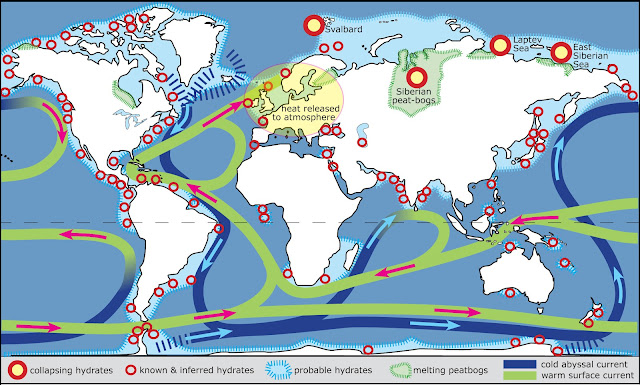Jake Greear
Johns Hopkins University
With world leaders failing to make headway toward curbing carbon emissions at the 2009 Copenhagen Conference, and quietly throwing up their hands at this summer’s Rio +20 Summit, it may be time for environmentalists to focus energies on the dispersed global sites of fossil fuel extraction. To that extent, the political battles now playing out in the Northeastern U.S. over the natural gas extraction process called hydraulic fracturing, a.k.a. “fracking,” merit attention.
As energy companies run up against the political and natural limits of petroleum and coal exploitation they are turning to increasingly outlandish means to tap alternative fossil fuel deposits like tar-sands--where extraction means scraping the living surface off vast swaths of Canada--and the natural gas held in the Marcellus Shale under the northern Appalachian Mountains--where extraction means shattering billion-year-old rock formations that undergird the North American continent.
Paul Thomas Anderson’s film There Will be Blood poignantly dramatized the violence inherent in fossil fuel extraction. However, the sites of large scale hydrocarbon extraction are often either sparsely populated or inhabited by communities with few means of resisting the insults and injuries that are the usual local byproducts of extractive industries. Most consumers of fossil fuels live a world away from their strip mines and oil fields.
The Alberta tar sands are an example. The construction of pipelines needed to carry tar sands oil to markets has been stalled for now, but the oil companies are not really worried. They will get the oil out one way or the other. The fortunate thing, from the industry’s perspective, is that not many people live in northern Alberta, so there is relatively little opposition in defense of the forests and rivers that are being destroyed there.
The Marcellus Shale formation, by contrast, runs under densely populated parts of West Virginia, Pennsylvania, and New York. The directional striations of the shale dictate the topological terms of methane extraction. The industry sees the entire area divided into a staggered checkerboard of 1/2 x 2 mile quadrants oriented north-northwest, with a gas well in each one. But to achieve this ideal energy companies must contend intensively with innumerable landowners and residents.
For many people living on the Marcellus Shale the revenues from gas extraction offer a way to ride out tough times on family farms that are obsolete by agribusiness standards. But the opposition movement that has grown throughout the region voices serious concerns about quality of life, environmental health, and safety. And in the ensuing political discussion bigger-picture issues like energy security, economic sustainability, and global warming have also become part of the conversation.
In New York state particularly, fracking has come to the forefront of local politics in many municipalities. Corporations long ago began haggling with willing landowners for drilling leases. However, they have not yet been cleared at the state level to frack New York, and while they wait for the state’s go-ahead several townships have moved to protect the neighbors who stand to be fracked against their will, adopting ordinances ban fracking locally. Although these efforts have met legal challenge, local anti-fracking ordinances have so far been upheld.
The opacity inherent in the fracking process has served to stoke an already heated controversy. First there is the fracking fluid injected underground in massive quantities. It is known to be toxic, but the contents are protected as trade secrets. Then there is the opacity of the earth itself. Seismic imaging, lab tests, and trial and error tell us something about what is happening in the fracking process, but there is a limit to what we can know about the deep earth. No one has ever been down in a fracking well--they are six inches across and miles deep. Like many other amazing technological feats, fracking remains an art even though it is served by science. And because it is an art there cannot be any guarantees of ecological safety. As with deep water oil drilling, no number of government inspectors will eliminate the extra-ordinary risks to lives, places, and ecosystems that an undertaking of this scale and technological complexity poses.
What we do know is that the earth is a big, complex thing full of surprises. Paleo-ecology tells us that our particular world is characterized by both resilience and fragility--prone to tipping points, feedback mechanisms, and emergent phenomena that are not predictable. Fracking is an amazing and ingenious technology that can do big things, like releasing a planetary amount of methane from the earth’s crust. But the problem with doing big amazing things is that other amazing earth-scale events can be unintentionally triggered.
So far the unintended consequences appear to be relatively localized--methane gueyser eruptions, man-made earthquakes, poisoned waterways, and a few polluted aquifers. Of course, few of these phenomena can be linked with certainty to fracking--once again, due to the opacity and complexity of the process. Corporate representatives use this opacity to industry advantage as “merchants of doubt” painting themselves as practical and reasonable--“just show us the proof?!”--while slick TV ads promise “clean burning natural gas” is the “transition fuel” that will usher in a green-energy economy... any decade now! The lie by omission is that the methane that necessarily escapes during the extraction process is many times more potent than other greenhouse gasses.
The fragile bulwark that some New York townships have erected against this well-lobbied industry draws upon the strong political tradition of “home rule” in the Northeastern states. Home rule is the decentralizing political principal within a federal system, giving local municipalities the right to institute any statutes not prohibited or superseded by higher levels of government.
There are voices on both sides who oppose New York’s adventures in ecological home rule. Some claim this issue is too complex and important to be left up to town councils. And of course whenever fracking is ruled on locally--either to permit or to ban--there will be a minority who feel strongly that their rights have been trampled upon. Moreover, some fracking opponents even worry that while each local anti-fracking ordinance seems like a grassroots victory for the cause, deference to home rule may give Governor Cuomo just the political cover he needs to give fracking a foothold in those townships that approve it. And yet, at a time when corporate money is bathing the machinery of the republic like never before, technocratic centralization is itself a suspect principle for environmental politics.
So whither ecological home rule? History tells us local direct democracy is no political panacea. Democracy can eat itself at any level. However, the fact that townships in the Northeastern states are taking a hard look at fracking is promising, whatever comes of it, if only because it has brought some of the complex political and ethical issues inherent in fossil fuel extraction home to many U.S. citizens as citizens. An active citizenry with a taste for the complexity of ecological politics is what we need most if the worlds leading carbon economy is to become an ecologically responsible representative democracy.












"An active citizenry with a taste for the complexity of ecological politics"
ReplyDeleteNonsense. This is a NIMBY (although justified) issue. This won't extend to "ecological responsibility" beyond those backyards.